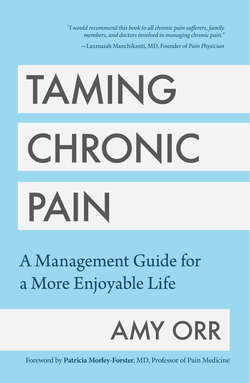Читать книгу Taming Chronic Pain - Amy Orr - Страница 19
На сайте Литреса книга снята с продажи.
ОглавлениеThe room is full of oddly shaped, baffling apparatus with shelves and seats and levers and switches and buttons and ropes and pedals and weights and platforms and oh my God, what are you supposed to do with that bar?
Gyms are intimidating—sometimes by design. A lot of people learn how to use a piece of exercise equipment by surreptitiously watching someone else use it. A lot, more simply, join a sports team, or cycle or run by themselves, or find a class, or simply don’t bother.
We all know that exercise is good for us and that most doctors recommend a minimum of thirty minutes a day, three times a week. That sounds like a lot. Being physically active is a vital component of pain management because, in addition to all the usual health benefits it offers, for chronic pain sufferers it can also:
•Increase strength
•Increase pain thresholds
•Decrease rebound time
•Encourage and speed healing
•Teach you your body’s limits
•Make more routine activities easier
•Encourage healthy sleep
•Release hormones that assist in mental wellness
Starting a new exercise regime can be overwhelming—there is just so much information out there—and adapting an existing one can be scary. What if you make things worse? What if you embarrass yourself? What if you create a new problem?
We are not going to set out any specific exercise routines here; for one thing, it would need to be different for every person. Every single person has to modify their physical activity according to their abilities, their goals, and their time. But knowing your abilities is important, as is setting reasonable goals.
Types of Exercise
Here are some really simple categories of exercise, all of which are recommended for everyone, but in differing ratios depending on your health and abilities.
Stretching
This is always beneficial, and knowing how to stretch properly is very important; it increases mobility, range of motion and flexibility, decreases pain, and softens the impact of more rigorous exercise.
Strengthening
Strengthening exercises are not just about lifting weights; they come in a wide variety of forms, and the simplest often involve using just your own body weight to exercise and tone specific muscles.
Cardiovascular
CV exercise is the type that gets your heart racing and has enormous long-term health benefits. It is often the hardest for those with chronic pain, but, remember, not all CV exercise is equal. There are low-impact options for those who must adjust their practices to their body’s needs that will still provide the important benefits you are looking for.
Safe Options for Exercise
There are several types of exercise that are widely considered “the safest” for those seeking to increase their physical activity in the face of existing physical problems:
•Stretching
•Yoga
•Walking
•Pilates
•Strength training
•Aquafit or swimming
And all exercise regimes, regardless of what type they are, should consist of four basic components:
1.Warm-up
2.Exercise
3.Stretch
4.Hydrate
There is almost infinite room within these basic guidelines to create and adapt a variety of possible workouts that will give you all the benefits of exercise without causing harm or triggering your pain disorder.
Know the Difference Between Good Pain and Bad Pain
Exercise hurts. Most of the time, for most people, just a little. You are not really working your muscles or pushing yourself if there isn’t some strain, some extra effort that can tire muscles and leave you achy and spent. That’s basically why so many people dislike it—it’s time-consuming and difficult and do I really have to?!
It’s important to know which pains you feel when exercising are normal and which are not. Muscle pain, strain or ache is normal after a heavy workout. It means you actually did something, so in many ways this can be considered good pain: you tired the muscle out, but that work will make it stronger. Some joint discomfort can also be expected if you have been working on a problem area, but again, this might be a good thing: moving and lubricating problem joints increases their mobility. If you have nerve damage, then this might be triggered by physical strain in the affected area. Normal after-effects such as these should decrease over time and can be temporarily alleviated by icing the area or taking anti-inflammatories.
But remember: no exercise should cause severe pain. Use the pain scale to monitor how you’re feeling; if your pain jumps while exercising, stop.
You should not have an increase of more than two points on the pain scale when doing any physical activity.
And none of the following should ever describe what you’re experiencing when doing safe exercise:
| tweakyburningjabbingpersistentsearing | wrenchingyankingrippingtearingstabbing | acuteshockspasming |
If you feel anything sudden, sharp, or that isn’t alleviated by pausing for a few moments, then stop what you’re doing and try something less impactful, smaller, or (if you’re having a bad day) simply come back and try again another time, starting slowly and building gradually.
Whatever your situation, your abilities, or your access to resources, there are some simple, common-sense rules you can follow to ensure you are taking the best care of yourself possible in regard to physical activity and pain.
Rules
1. Go at Your Own Pace
You absolutely have to get comfortable ignoring what everyone else is doing. You are not in someone else’s body, and they do not know how your body is reacting internally. Whether you’re in the gym, in an exercise class, playing team sports, or exercising on your own, you have to be able to read your body’s signals and slow down, modify, decrease weight, take a break, or stretch it out, if that is what your body is demanding.
